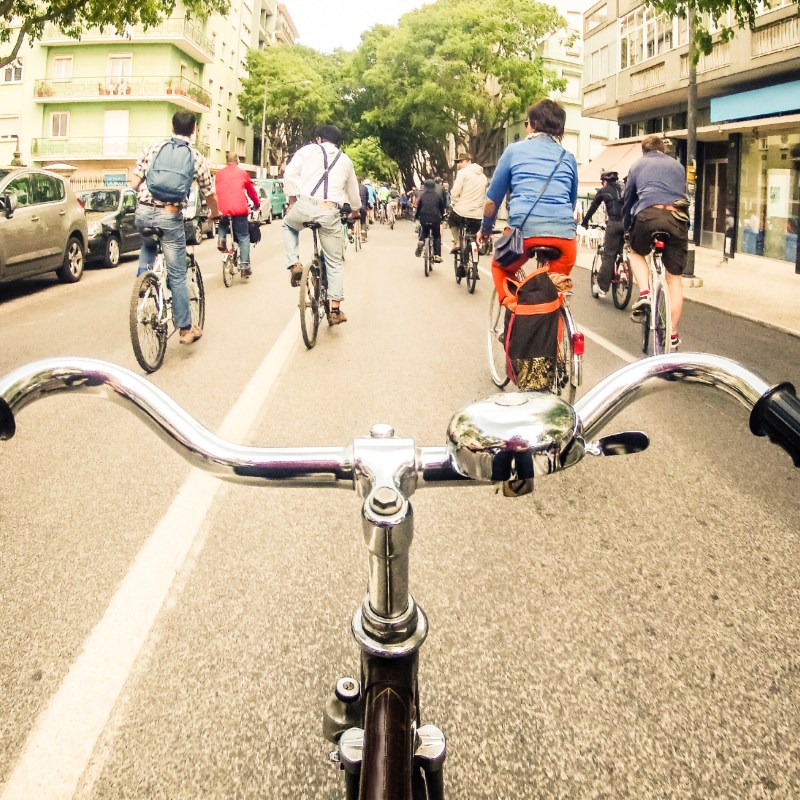
If you haven’t been fussed at by a German for stepping into the bike lane, have you really experienced the country?
Videos by TravelAwaits
Just kidding—I’m projecting.
Just because I’ve been scolded in Munich, Berlin, Hamburg, and Dusseldorf for not minding the bike lane, it doesn’t mean you’re just as hopelessly blind to the subtlety of cycling traffic. (I blame my Midwestern background; as of 2025, bike lanes are still a pipe dream in most big cities in the middle of the country.)
Even when I was in New York City, the bike lane was a free-for-all—sort of like a no-holds-barred Autobahn for people riding bicycles, skateboards, electric scooters, and electric bikes.
And while bike trails aren’t hard to find around the United States, from Florida to the Allegheny Mountains, these are largely rural.
When it comes to urban bike lane rules, many Americans like me have needed a little introduction. Plus, a few reminders on how to recognize a bike lane and stay out of it.
Where are you likely to run into lots of bike lanes?
Europe is home to the world’s most active urban bike lanes. That’s thanks to the condensed nature of the continent’s largest cities.
Having evolved and expanded during the Middle Ages, many European cities have small, winding downtown areas that are easier to navigate on foot or by bicycle instead of with a car.
In other words, bike lanes are the most viable way to get around. They’re also viewed as a sustainable and affordable alternative to a gas car or even an electric car.
If you’re heading to these European cities, expect to navigate bike lanes often: Copenhagen, Amsterdam, Utrecht, Berlin, Munich, Paris, Strasbourg, Oslo, Helsinki, and beyond.
Usually, the further north you go in Europe, the more likely you are to find high-quality bike lanes that are used by thousands each day.
Why do people get so pissed off about stepping into the bike lane?
The first time I was reprimanded for stepping into the bike lane, it was a minor infraction. I’d barely stepped a toe over the line and thought… this person must not have any real problems.
That was ten years ago. Now that I’m all grown up (and then some), I can appreciate why stepping over the bike lane line is rage-inducing.
First, it’s dangerous. Bike lanes are high-traffic zones and, during rush hour, can be very congested. One little mishap can cause a multi-bike pile-up, and these can cause broken limbs, fractures, and other serious injuries.
Second, it’s infuriating. We’ve all experienced road rage—it’s not specific to cars. Road rage is just a revolving door of hatred for whoever happens to be in your way, regardless of the mode of transportation.
In other words, getting mad because someone almost made you crash isn’t exclusive to cyclists.
5 bike lane rules to know
Rule #1: Bike lanes have different usages
Some bike lanes are just for cyclists—these are usually where you’ll get a special ‘shout out’ if you’re in the way, as they tend to have a lot of fast-moving traffic.
But other bike lanes are also multi-use, including for pedestrians and families. So, if you’re confused about whether a bike lane is open to you as a pedestrian, look for a sign—you might have the right of way.
Rule #2: Look for lights
While we usually associate cycling as a daytime activity in the US, let’s not forget: it’s more widely used as transportation in many European cities. And almost all require cyclists who ride at night to have flashing lights that you can clearly see.
So, even if you assume bike lanes have quieted down for the night, keep a lookout for flashing lights.
Rule #3: When near bike lanes, keep your ears open
That brings me to my next point: most European countries mandate that cyclists have a bell or other audible warning device.
I know this advice probably seems painfully obvious, but tourists tend to be the most distracted people in a given city—it’s easy to stop paying attention. If you’ve had a run-in with a bike lane already, try to train your ears to listen for those familiar warning bells.
Rule #4: E-bikes aren’t always allowed
Look back at rule #1 if you plan on grabbing your own bicycle on vacation. If you’re comfortable cycling, don’t be afraid to enjoy life in the fast (bike) lane—but be cautious if you’re going to rent an electric bike or E bike.
Some cities don’t allow them in the bike lane or might prohibit them in more congested parts of the city.
Rule #5: The rules change
Every country in Europe has a different set of laws surrounding cycling. In Spain, for example, its compulsory to wear a helmet. If you’re going to set off in the sunset on a bicycle, make sure you ask the rental company about the rules of the road.
In some countries, you might even notice that different cities have different ordinances on bike lane rules—similar to how every US state has a different take on whether drivers can turn right on a red light.
